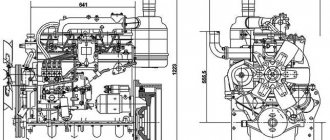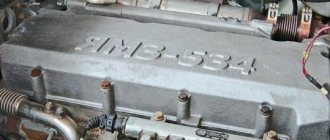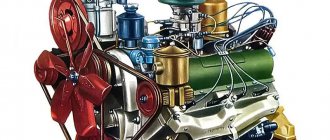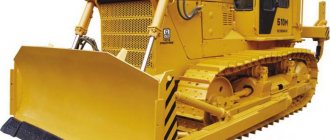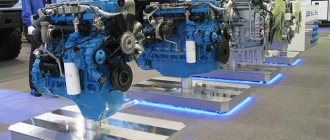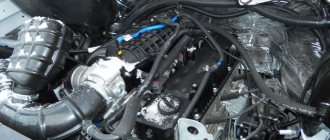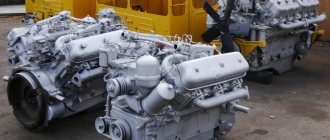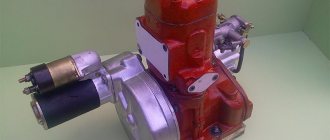GAZ 52 trucks are a symbol of the Soviet era. The power units installed on these vehicles are so reliable that they are popular among many motorists today. The six-cylinder in-line gas 52 engine can successfully operate on gasoline and liquefied gas. The main brand of gasoline is A 72. After modernizing the cylinder head, the compression ratio was increased, as a result, the engine switched to consuming A-76 gasoline. For the convenience of drivers, the digital designation “76” is stamped on the body of the new head.
GAZ 52 engine design
The new designation for this power device is GAZ 52-01. This marking was assigned to it as a result of the modernization of the GAZ-51 engine. The main goal was achieved; the maximum power of the forced GAZ 52 engine became 75 horsepower.
List of targeted design changes:
- Updated pistons are made of AL-30 aluminum alloys with a high silicon content.
- In the manufacture of bearing shells (connecting rod, main), unique technologies are used. The blanks consist of: steel strip, copper-nickel layer, lead alloy SOS-6/6, which has anti-friction properties that help increase the resistance of bearing shells against abrasion.
- The material used to manufacture the exhaust valves is heat-resistant steel grade 55Х20Г9АН4 or EP-303.
- A K-84MI or K-126E carburetor, consisting of two chambers, was introduced into the engine design
- Redesigned intake manifold.
- Fuel pump model B-9B, with a capacity of at least 140 liters per hour.
- An open ventilation system is installed.
- Air filter in a combined version (inertia oil). The filter element is made of high quality nylon.
The compression ratio remained unchanged at 6.2. In order to unify with the components and parts of the engines of the GAZ-53 family of cars, many elements have not undergone changes. List of relevant standardized parts and assemblies:
- crankshaft;
- cylinder block;
- gas lines;
- lubrication system housing;
- crankcase ventilation filter;
- starting heater, etc.
Technical characteristics of the GAZ 52 engine
| Motor type | carburetor K-126I |
| Number of cylinders | 6 |
| Number of cycles | 4 |
| Valve location | lower |
| Developed power | 75 horsepower at 2800 rpm |
| Compression ratio | 6,2 – 6,7 |
| Torque | 21 kgf. m at 1600 – 2000 rpm |
| Engine displacement GAZ 52 | 3485 cc cm |
| Lubrication system operation | spray method and under pressure |
| Oil filter type | fine, coarse cleaning |
| Cooling system | liquid, water circulation – forced |
| Fuel | gasoline A-66, 72, 76 |
| Gasoline tank capacity | 90 liters |
| Spark plug | A-11 |
| Amount of coolant in the system | 16 liters |
| Specific fuel consumption | 20 l per 100 km |
| GAZ 5 engine weight | 250 kg, (306 kg assembled with gearbox and clutch) |
| Cylinder diameter | 82 mm |
| Piston stroke length | 110 mm |
| Cylinder operation formula | 1-5-3-6-2-4 |
| Cylinder block material | iron casting |
| cylinder heads | Aluminium alloy |
| pistons | aluminum high silicon alloy |
| fingers | steel |
| crankshaft | steel forging |
| bearings | trimetallic liners |
| camshaft | steel forging |
| Oil pump type | single-section gear |
| Fuel pump | diaphragm type |
| Engine production period | 51 years (from 1964 to 1993) |
Chassis
The GAZ-53 truck is based on a riveted frame assembled from side members made by cold stamping. The design has six crossbars for power purposes, as well as a crossbar for an outboard bearing. A device for towing a trailer is mounted on the rear cross member.
The axle suspension is dependent, spring. The rear springs are equipped with additional springs. The front axle suspension has two telescopic shock absorbers.
Features of operating the GAZ 52 engine
In 1978, the manufacturer published a special accompanying document “GAZ-52 Operation Manual”. It described in detail the operational parameters, as well as recommendations for the maintenance and use of this internal combustion engine.
It is known that the GAZ 52 power unit has the following features:
- loses stability when operating at high speeds;
- Fuel consumption, engine oil consumption and wear rate are directly dependent on the operating temperature of the engine.
Based on this, drivers are given the following recommendations:
- Provide a coolant supply at a temperature of 80 to 90°C.
- When the ambient temperature drops, protect the engine radiator grilles from the cold using a special insulating cover.
- When switching to A-76 gasoline, a corresponding adjustment of the ignition angle is required.
Gearbox, overall dimensions
In addition to the engine, the car received a reliable and quiet five-speed gearbox. It was equipped with synchronizers in 3rd and 4th gears. Dimensions were 5725-2280-2155 mm, the wheelbase reached 3300 mm, and the front wheel track was 1590 mm. The rear wheel track was 1650 mm. The car was equipped with tubeless tires. The weight of the car was 2650 kg. The maximum developed speed reached 75 km/h. As for fuel consumption, this parameter reached 24 l/100 km.
Modernization and technical improvements of GAZ 52 engines
The most common breakdown in this internal combustion engine has always been considered premature wear of the connecting rod liners when operating the vehicle at high speeds. This was his so-called Achilles heel. This drawback brought drivers a lot of trouble and a lot of trouble.
The thing is that these parts had only one hole for the passage of lubricating fluid, which was not enough for these units. A successful solution was the advice of experienced mechanics. They suggested using liners borrowed from the ZIL-130. These parts fit perfectly in size instead of the old samples. The material used to manufacture the ZIL 130 liners is an alloy of steel and aluminum. This material is so hard that it is impossible to drill an additional hole for the passage of motor oil at home. An excellent solution was to cut special grooves in the upper soft layer of metal. As a result of the appearance of grooves 2 millimeters wide and deep, the passage of lubricant has improved significantly.
Tip: To prevent oil from leaking through the hole in the connecting rod, it is recommended to plug it using improvised means. For example, a small piece of foil will do.
After turning the channels, a significant decrease in oil pressure in the lubrication system was noted, which did not allow the vehicle to be operated at high crankshaft speeds (less than 70 km/h). What helped? The GAZ 52 engine became completely indestructible after work was carried out to reduce the gaps between the gears in the oil pump, as a result of which the pressure in the lubrication system significantly increases.
Changing the height of the oil pump and reducing the weight of the GAZ 52 engine pistons
Grooving connecting rod bearings is not the only innovation that can improve the performance of an internal combustion engine.
- To increase the pressure in the lubrication system, the parameters of the oil pump are also changed - its height dimensions are increased, following the example of the so-called “double-deck pumps” used in military equipment (in power units installed on the BTR-50). The pump design is complemented by additional standard gears. As a result, a large pump provides engine oil pressure in the system of at least 6 atmospheres.
- To reduce weight and reduce friction forces of the pistons, their length is reduced (the “skirts” are cut). For this purpose, not original pistons are used, but borrowed from the Moskvich-412 car. This will help reduce stress on the crankshaft journals.
Benefits resulting from reduced piston weight:
- the operation of the power unit is stabilized;
- noise effects are reduced;
- fast acceleration;
- reduction in fuel consumption.
Interesting: Some mechanics practice installing the cylinder head without the usual gasket. It is noticed that the distance between the cylinders here is very small. At short intervals, the cylinder head gasket cannot withstand ultra-high temperatures of 2000°C and burns out completely. Instead of the gasket, it is proposed to use a special heat-resistant paste.
Advice: In addition to the listed upgrades, experts advise changing the recommended mineral grades of motor oil to high-quality synthetics in the lubrication system of the GAZ 52 engine.
Cabin
GAZ-52, whose technical characteristics allowed the car to become the most popular Soviet truck, was produced with a new cab. The cabin had a special design. No one could have imagined that she would be popular for so many years.
This cabin had an all-metal body and was designed specifically for use on this vehicle. It included a hood layout, and the windshield had improved characteristics compared to outdated GAZ models. The new windshield made the view more panoramic. The cabin was designed for only two people. For driving comfort, a heater was installed that blew the windshield, wipers with vacuum technology and new side windows.
Why is it interesting to boost the GAZ 52 engine?
After such simple upgrades, the main problems of the GAZ 52 engine completely disappeared. Now he is not afraid of daily operation at maximum crankshaft speeds under any conditions:
- Heat, frost, sudden changes in ambient temperature.
- Road surfaces of varying quality (from smooth asphalt of highways to broken country roads).
- Driving on flat surfaces, as well as on roads with sharp descents and ascents.
Important: The information posted in the previous section contains data based on the recommendations of experienced car owners who have boosted the GAZ 52 engine.
The main advantages of GAZ 52 engines:
- simplicity of design;
- relatively low cost;
- reliability;
- long service life (more than 200,000 km);
- absence of complex devices such as chains, rods, tensioners, dampers, balancers, rollers, etc.
Design stage
Thus, the country's leadership set a task for the management of Soviet automobile factories. Engineers and designers had to create a cargo transport project for cargo transportation in the conditions of villages and cities in the shortest possible time. And so designers from Nizhny Novgorod set about designing the GAZ-52 truck. According to the project, its carrying capacity was 2.5 tons. And it was created on the basis of the GAZ-51A car, which was produced since 1955.
Soon this car completely replaced already outdated cars. The new truck differed from the old one in its cab. It seemed that its design was similar to American cars of the same era. During the design (and later production), no one could even imagine that this truck would be popular for 30 years.
GAZ-52 carburetor engine diagram
With gearbox and clutch mechanism in longitudinal section:
1. Gasoline pump; 2. Radiator valve; 3. Clutch mechanism; 4. Gearbox housing; 5. Gas main; 6. Coolant drain drive; 7. Carburetor K-126I; 8. Air cleaner filter.
GAZ 52 engine cross section:
1. Drain plug; 2. Oil receiver; 3. Carter; 4. Ventilation; 5. Oil pump; 6. Heating device; 7. Ignition system coil; 8. Coarse filter.
Features of mounting the GAZ 52 engine
The power unit is installed on the vehicle frame. Fastening is carried out at 4 points at the locations of special support pads made of rubber with vulcanized metal reinforcing inserts. The feet of the engine housing are securely fixed to the supports.
When attaching the engine housing, use:
- special bolts;
- brackets;
- spacers;
- metal rods;
- nuts;
- washers;
- rubber gaskets of the same thickness, etc.
Gaps between the legs of the engine housing and the supports are eliminated by securely tightening the threaded connections.
Installing Valve Covers
After adjusting the valves to gas 53, the valve covers are closed. This is also a whole science. The lids are made, one might say, of tin. Easily deformed. Before installation, you need to check the flatness of the covers. To do this, they should be leaned against a flat surface. Adjust the lids if they do not fit tightly.
Rubber bands are installed. Along the edge of the lid. At the points of fastening with studs. There should also be rubber seals. There is no need to tighten the lid too much. Otherwise it will become deformed again. Proper installation of the cap will prevent oil leakage. Aluminum covers are also provided on such engines. They were usually installed on cars intended for the army. Engines for GAZ 66 are always equipped with these valve covers. They, of course, fit tightly on the plane. And they have no problems with oil leakage. The equipment made for the Army is significantly different from the equipment for the national economy. Previously, if a decommissioned military vehicle ended up on a farm. It was much more convenient than buying new.
How to maintain the GAZ 52 engine
The range of maintenance work for the GAZ 52 engine includes the following items:
- Checking the reliability and tightening fastenings of working units and parts.
- Dismantling and washing the filter element of the fuel sump.
- Make sure that the clutch pedal has free play of 34 - 45 mm.
- Check and additionally tighten the bolts securing the engine mount to the support pads.
- Visual inspection of the oil cooler, hoses, faucet for possible leaks.
- Checking the tightness of connections of power system elements.
- Washing the strainer of the injection pump pump.
- Changing engine oil in the GAZ 52 engine.
- Cleaning of coarse and fine oil filter housings, changing filter elements.
- Checking the condition of the crankcase ventilation tube of the power unit.
- Checking the tightness of the cylinder head fastenings (this operation is carried out when the engine housing has completely cooled).
The engine oil in the GAZ 52 engine must be changed after a travel distance of 5 - 7,000 kilometers. The interval between these operations changes towards decreasing/increasing, depending on the severity of the operating conditions of the vehicle. The amount sufficient to replace the lubricant in the GAZ 52 engine ranges from 7 to 8 liters.
List of recommended brands of motor oil for the GAZ 52 engine:
- all-season mineral motor oil AS-8 (M-8B);
- semi-synthetic Lukoil, Gazpromneft.


